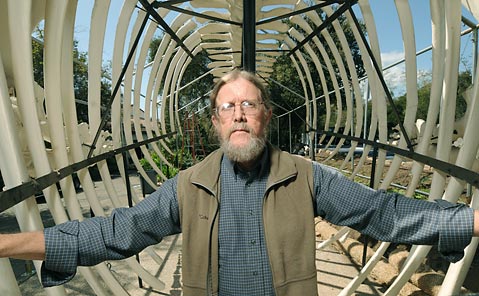Bye-Bye Blue Whale
Museum of Natural History’s Skeleton to Be Restored and Reinstalled in More Anatomically Correct Position

The Santa Barbara Museum of Natural History’s Museum’s Blue whale skeleton — in place since 1983 and one of only five complete specimens on display in the United States — is in need of some serious tender loving care.
Years of exposure to the elements, coupled with over-zealous visitor “touching,” has caused widespread damage to the skeleton, with large sections of its protective coating sloughing away from the delicate bone underneath. The skeleton had become so fragile, according to officials, that not long ago the museum restricted visitors from walking through and around it for fear of possible breakage and visitor injury.
As such, museum staff — headed by vertebrate zoology curator Paul Collins — recently dismantled the 7,700 pound, 72-foot skeleton in order to have it repaired and cleaned. The week long dismantling process, which necessitated the use of a forklift and the help of a four-man team, prepared the specimen for its journey to Academy Studios in Novato, California. As of press time, the whale has been completely taken apart and is in the midst of its “migration” up north in a 30-foot truck. Each piece, reported Collins, was painstakingly labeled and organized before it was packed, and that the spinal column was divided into three large sections for transport.
At the skeleton’s temporary destination, explained Collins, restoration workers will remove old paint, repair cracks, and rebuild missing or broken sections. They will also, he said, impregnate the bones with an epoxy in order to stabilize and harden them and to allow the protective paint coating to hold better. The skeleton — which is of a young male blue whale that washed ashore near Vandenberg Air Force Base in August 1980 — has received two similar, major repairs in the decades since it was installed.
Collins explained that the original skeleton will return to the museum in about four months in its near-entirety, with one major exception: The original skull (which remains at the museum and weighs 3,542 pounds on its own) will be replaced by a new skull harvested from a 2007 blue whale stranding in Ventura.
Right now, the new skull is still being cleaned and prepared at a Gaviota facility, undergoing an intensive maceration process that began in November of last year and is expected to last until mid-July. It will eventually be moved to Academy Studios as well, but not before it is intermittently soaked in a custom-built tank as well as steam-cleaned to rid it of any remaining tissue.
When the new skull and original bones are transported back to the museum, Collins explained, they will be reinstalled but in a new, more anatomically correct position. “By studying [Blue whale] morphology and biology, as well as listening to specific criticisms from other scientists, we have a much better idea of how the skeletal and muscular systems work,” said Collins. “We’ve been studying how baleen whales feed, specifically looking at how the mandible rotates out and then back in instead of just opening and closing.” The lower part of new mandible, he said, will be lowered and placed at a different, more correct angle.
Collins also described how, by studying the museum’s Minke whale specimen (the smallest of the baleen whales), they’ve been able to create a more accurate representation of a Blue whale’s anatomy. “We’re not just accepting how whale skeletons were displayed in the past,” Collins said, referencing the extensive research that has gone into the repositioning plan. “People assume that a skeleton is accurate just because that’s how it’s been done before. We’re trying to get away from that.” Collins also indicated that a few eye and finger bones that had been missing from the original skeleton will also be added.
When all is said and done, the blue whale skeleton will be even more of a treasure than it was before the restoration. This skeleton,” said Collins, “will be one of the most complete and correct blue whale skeletons on display in the world.” He went on to claim that, upon completion, it will contain 98 to 99 percent of all of a Blue whale’s bones but that the average visitor “won’t notice much of a difference.”
By speaking with other curators who’ve worked with large skeletal armature, Collins said, museum staff was also able to develop new installation strategies. Improvements include switching from metal to stainless steel bolts to prevent rusting as well as utilizing carbon fiber support rods that won’t oxidize and damage the bones. The entire support system will also reportedly be much more rigid than the last, preventing the skeleton from swaying and moving should it be jostled. “A lot of people would shake the ribs to watch the whole skeleton move,” said Collins, “which would cause the bolt joints to degrade. These new strategies will prevent that wear and tear.”
Other improvements will be made to the exhibit, Collins explained, including updated signs, lighting, and landscaping. According to Collins, a shadow of a full-sized blue whale — muscle, fat, skin and all — will be added to the substrate below the skeleton to give visitors a sense of the sheer size of a living specimen. Visitors will also be able to once again access the skeleton from both sides as well as underneath, and a wheelchair-access ramp will be built.
According to the museum, the first two phases of the restoration project (preparation and installation of the new skull and the restoration of the original skeleton) will cost about $500,000, of which the museum has raised $350,000.



